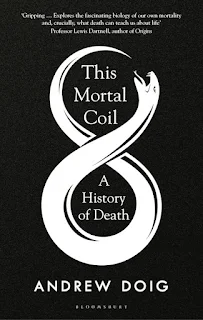Our health has changed dramatically over the centuries, and in This Mortal Coil - A History of Death by Andrew Doig, the author explores the main causes of death we face today (heart disease and cancer) and how they vary from the illnesses and diseases from the past.
Doig introduces us to the Bills of Mortality in Chapter 2, and tells us the lists started being kept in the 1590s as a method of recording and reporting how many people were dying from the plague each week. The list was later expanded to include all causes of death, some of which have held particular interest over the years. (You can check out the medicinal remedy for quinsy in my review of The Time Traveller's Guide to Medieval England by Ian Mortimer.)
Here are some of the choice examples of the causes of death recorded in a Bill of Mortality from 1664:
Affrighted = Frightened to death
Dropsy = Abnormal swelling of the body caused by the build-up of clear watery fluid. Often caused by kidney or heart disease
Falling sickness = epilepsy
Griping in the guts = sudden, sharp pain in your stomach or bowels.
Rising of the lights = a rather poetic name for coughing your lungs up.
Sweating sickness = Infectious and often fatal epidemic disease affecting England in the fifteenth century. Exactly what it was is a mystery
I borrowed a copy of This Mortal Coil from my library as well as listening along to the audiobook, as some of the chapters contain graphs and tables and while rather expertly narrated, I was still keen to examine the print version of the data.
After reading chapters about life expectancy in different countries and across time, genetic diseases, plague, famine, scurvy, and sorting out the difference between typhus and typhoid,* my most memorable fact from the book came from learning about cholera. I knew the story about John Snow and his map of the Broad Street Pump (which also came up while reading Maphead by Ken Jennings, which I'll be reviewing next), but I didn't know anything about the dreadful symptoms of this terrible illness.
"Faeces are normally brown, as they contain dead red blood cells. The bad smell is molecules containing sulphur. In contrast, the diarrhoea from cholera is white and very runny, resembling water that has been used to cook rice, and can also smell of fish. Stomach cramps, nausea and vomiting also occur, adding to fluid loss. As the dehydration takes hold, victims experience irritability, lethargy, sunken eyes, loss of saliva, dry and shrivelled skin, and (unsurprisingly) extreme thirst. Blood turns acidic, urine production stops, blood pressure falls and the heartbeat becomes erratic. Losing salts in the blood causes muscle cramps and shock, as blood pressure becomes dangerously low. Patients scream and thrash as their muscles spasm, before they collapse exhausted." Page 100-101This sounds like like a horror movie! I once believed ebola was the worst way to die, as seeing/being someone bleeding from the eyeballs was surely the most unnatural and horrific sight. However, now I'm thinking cholera - also known as the blue death - has got to be one of the worst illnesses, and seeing white runny diarrhoea would chill you to the bone, wouldn't it?
This Mortal Coil is full of interesting facts from history while never being grim or dull, and to my point, Doig opened my eyes to an entirely new mania. I enjoy learning about tulip mania and the dancing mania, and I'm familiar with railway mania, but I was stunned to learn there was a period of canal mania in British history. The author tells us:
"The success of the Bridgewater Canal (which is still in use) helped trigger canal-building mania in Britain from 1770 to 1830, with more than 4,000 miles built. Canal mania was followed by railway mania from 1830. Rail passenger numbers jumped from 5.5 million in 1838 to 111 million in 1855." Page 147-148Now that I reflect a little, I think canal mania was building in the TV series Gentleman Jack, wasn't it?
Published in 2022, This Mortal Coil by Andrew Doig is up to date with the inclusion of Covid and is highly recommended to readers with an interest in history, health, science, medicine and medical science discovery.
* Typhus is caused by bacteria spread by fleas and lice, and Typhoid is caused by Salmonella Typhi from contaminated water or food.




































